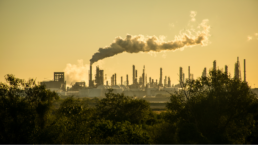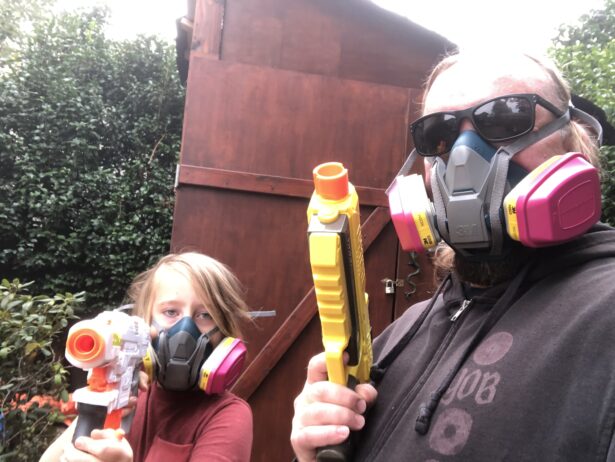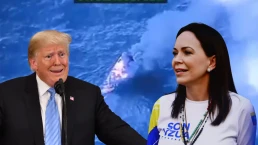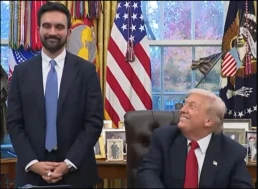By taking collective action, we step out of our sense of helplessness into a realm of working to change the conditions giving rise to those emotions.
By Paul Messersmith-Glavin, Waging Nonviolence
I watch the bright orange glow of the approaching fires from our southern window. The “get ready to evacuate” line is moving ever closer, stalling out only a mile away. My partner, eight-year-old child and I roll up towels, placing them at the base of our front door to prevent toxic wildfire smoke further seeping in. We don’t have air purifiers. We are scared.

After several days, feeling claustrophobic and wanting to play, my child and I decide to venture out. Donning Portland-appropriate respirators and goggles — necessitated by the police force’s habit that year of gassing entire neighborhoods in response to a popular uprising insisting Black lives matter — we load nerf guns, secure lightsabers and open the door. Once outside, in the thick, swirling smoke and eerie glowing sky, my child says they feel like we’re on an alien planet. We kind of are. Even with our protective gear, weapons and a strong desire to play, we are quickly overcome by the overwhelming smoke. We goof around and play out scenes from “Star Wars,” only lasting five minutes before rushing back inside, marveling at how strange and awful it all is.
This was the summer of 2020, when Oregon was in the midst of a drought with unusually high summer temperatures. The Oregon fires that year burned five million acres, an area the size of New Jersey, killing 17 people and destroying thousands of homes. I feared the flames would leap into the city, setting off a block-by-block blaze, like what happened in Chicago 150 years ago.
Growing up in Chicago, we heard a lot about the Great Fire of 1871. What many people don’t realize is that the fire actually had more to do with climate stressors than Mrs. O’Leary’s infamous cow. Portland, like Chicago at the time of the Great Fire, is mostly made up of wooden houses in residential neighborhoods, and the thought of forest fires engulfing the city didn’t seem far-fetched. The fires got as close as Portland’s southern suburbs.

While the fires never reached Portland that summer, many other cities around the world haven’t been as lucky in recent years. During the hottest day in London history, last year, that city’s fire brigade had its busiest day since World War II with fires rapidly spreading through the city as a “heat dome” sat over Europe. Over 1,000 homes burned in the suburban sprawl of greater Denver, Colorado that same year. And recently, nearly the entire town of Lahaina, in Hawaii was destroyed. This represents what climate scientist Daniel Swain calls the emergence of the “urban firestorm.” My fears were not unfounded.
This summer saw Canadian wildfire smoke smoother Chicago, New York City, and other Midwest and East Coast locations, broadening to millions more people this eerie experience. On the West Coast, we’ve been enduring this for years. A previous summer I ended up in the ER with severe respiratory distress from severe wildfire smoke. I spent the better part of a week on the couch, taking oral and inhaler steroids, trying to recover, missing a major confrontation downtown with neo-fascist “patriots” that my comrades and I had spent an intense series of weeks preparing for. Another recent year, ashes fell on my family and friends during a backyard Labor Day BBQ, confusing and startling us, when a raging wildfire consumed part of the dearly loved Columbia River Gorge. Incessant and widespread wildfires are a fairly recent development. Forest fires are a healthy part of forest ecology; the hellish infernos that now rage each year are not.
As horrifying as the heat domes, urban firestorms, atmospheric rivers, and catastrophic floods have been, someday this will be looked back upon as just the beginning, when the climate was only starting to veer off course; when there still was a chance to intervene to prevent bigger horrors occurring. In March 2023 the Intergovernmental Panel on Climate Change said, “There is a rapidly closing window of opportunity to secure a livable and sustainable future for all.” Scientists give us only a decade to fundamentally change society — most significantly stopping burning fossil fuels — before runaway climate change is locked into place through cascading tipping points and humanity is doomed to a miserable existence, if one at all.
I feel obligated to prepare our child for this emerging world. At the same time, I’m compelled to help make that world less of a nightmare; to be involved in stopping, or at least slowing, the rapidly unfolding disaster. This preoccupies me every day as I make breakfast for my family or my kiddo and I play catch in the street. How can we most effectively use our limited time to both help create a society that doesn’t actively change the climate — where we don’t have to stay inside due to overwhelming smoke or in fear of catastrophic floods — and act to halt any further emissions of greenhouse gasses? How do we prepare our children to navigate the world that is coming?
Grief and the lungs
During a year I lived and worked in China — starting in 2007, when Portland still took pristine summer air and perfect weather for granted — I was overwhelmed by the constant smog; rarely, if ever, could I see the sun, or blue skies, for more than the length of a city block. My partner and I visited the Great Wall in Beijing, but it was largely hidden by smoke. Ecologically, China felt like a wasteland, though one obscured by the bright glow of rapidly spreading consumerism and constantly constructed shiny new buildings. One of the final scenes of the film “Brazil” comes to mind: a car driving down a billboard enclosed highway, clear-cuts and ecological devastation hidden from view.

In Beijing, my partner and I visited the Forbidden City before crossing the street to see Tiananmen Square. There we stood in line to see Mao’s body — under a red hammer-and-sickle flag, inside a hermetically sealed case guarded by a lone Red Army soldier — only to be whisked past the chemically preserved Mao to the gift shop, where we were encouraged to buy an assortment of lighters and clocks and other trinkets with the Great Helmsman’s image. Despite being in Beijing several times, we never got a sense of just how big and sprawling it is, receding as it does into the smoggy mists of domestic energy production and consumer goods manufactured for export. Like the misnamed London Fog of the 1800s, Beijing Smog is the result of political and economic decisions.
I spent most of my time in China in the city of Chengdu, in Sichuan Province, in the southwest part of the country. I practice Chinese medicine, and had the opportunity to study at a traditional Chinese medicine university and intern in a hospital. I rode my bike from Sichuan Normal University campus, where we were housed and my partner taught graduate linguistics, to the Chinese medicine university and hospital, about a 45-minute bike ride each way. We noticed, strangely, that we often yawned when riding our bikes. That felt weird — bike yawns? We speculated that we yawned due to the lack of oxygen our bodies were experiencing, a thought that made us laugh uncomfortably. Our bike yawns, we speculate, were simply triggered to help provide our lungs more oxygen, while helping clear pollutants out of our blood. When I yawn now, I think of my China bike rides.
In Chinese medicine there is a relation between the lungs and grief. Medicine in China grew out of indigenous Daoist traditions, particularly the understanding of yin and yang — each contained in the other in nascent form, then transforming into its opposite — and the five elements (water, earth, fire, wood, metal) associated with five literal and metaphorical internal organs, each in turn related to distinct colors, seasons, tastes and emotions. Like the dialectical movement of yin and yang, the five elements move through spiraling cycles with wood feeding fire, fire creating earth, earth bearing metal, metal collecting water, and water nourishing wood. The elements not only enable but also constrain each other. In Daoist cosmology, the fundamental life-force is Qi. All sentient beings have Qi and, like in animism, everything in nature and the universe also has Qi. Our lungs bring in Qi from the air, mixing it with our inherited Qi, the jing, and the Qi we receive through eating food. In the lungs lives the po, thecorporeal soul, or that aspect of our consciousness that dissolves when we die.

Existentially, in China, I felt I was living in a possible future of this planet; one in which we can no longer see blue sky, sun or even down a city street; where fresh air becomes a rare, sought after commodity and one struggles to simply get enough oxygen. My year in China really put me in touch with my po, my mortality. I felt profound grief being in this possible future, carrying it in my smog-challenged lungs. I brought this, and subsequent depression, home with me, resulting in lethargy and a lack of initiative. I lost my motivation to try and change the world. It felt pointless, futile; we were doomed. Climate scientists who study what is happening also experience this kind of depression, as well as anger, fear and a sense of panic.
Organizing and hope
Settling back in Portland after a year in China, I sought to alleviate my grieving emotional state and battered lungs by organizing a study group to try and get a handle on the causes of our dystopian trajectory. I agree with those psychologists, such as Staci Haines and Michael Lerner, who understand distressed emotional states as being in part produced by social structures, resulting in the prescription of organizing for social change as part of any antidote. I thought if I could understand, intellectually, why the climate crisis was happening I might be able to overcome my pervasive sense of dread.
I first realized the ameliorative power of organizing when, as a teenager, awareness of the threat of nuclear war gave me overwhelming anxiety. In the 1980s people in the Reagan administration where talking about “fighting and winning” a nuclear war with the Soviet Union. A massive direct action movement rose up in opposition to this in Europe, where the U.S. hoped to station a new generation of “first strike” nuclear weapons, and it eventually rose in the U.S. as well. I threw myself into this movement, marching with 70,000 people in downtown Chicago and over a million in New York City; attending and organizing speak-ins, die-ins and teach-ins; and going to predawn blockades of weapons manufacturers. We formed study groups and created organizations. My anxiety and despair subsided through reflection and action.
It’s a common understanding among organizers that developing consciousness, through collective reflection and reading about the history and nature of one’s circumstances, is a first step toward cultivating solidarity through common action. This is what my partner and I did in Portland upon returning from China. Beginning as a study group, a half-dozen of us calling ourselves the Parasol Climate Collective developed into also doing political organizing and public education. We began to reach out to groups working on issues such as police abolition or workplace organizing, providing a context for them to better understand how the changing natural environment influences their work. We sought to draw connections between immediate concerns, like immigrant rights, to larger social ecological dynamics.
In joining with others to change things, we step out of our sense of helplessness, and the denial necessitated to get through each day, into a realm of actively working to change the conditions giving rise to those emotions. Cassie Thornton, in her work with mutual aid health care solidarity initiatives in Greece, reports how the “other face of the crisis is solidarity.” She noted how a woman and her friends experiencing the devastation of Greece’s financial crisis, after becoming involved in social movement work, experienced “the birth of their new lives as radicalized people within activist communities, people who found a purpose, who were becoming more than workers and consumers, who now felt powerful, connected, and interdependent.” There is no individual, lifestyle change that will stop the climate crisis, only society-wide change, collectively organized will.
Since the 1990s, I have been involved in grassroots organizing around issues related to the ecological crisis and its primary cause, capitalism. In this time, it’s become perfectly clear that the most cynical reading of ruling class intentions — that they don’t give a shit about us — is the most accurate. Mike Davis’ “Late Victorian Holocausts: El Niño Famines and the Making of the Third World” demonstrates how, in a previous era, capitalists took advantage of adverse environmental conditions to advance their interests by profiting off widespread misery. In the 1800s, famine and drought, in what was to become the “Third World,” laid the basis for some of the first capitalists to build their empires by exploiting people’s suffering, locking in structures of extraction and looting that exist to this day. Those in charge will continue to accumulate wealth while the vibrancy and beauty of life fades — that is, if the majority of us don’t get organized and intervene.
I put my hope in everyday people’s ability to rise to the challenge of remaking society, rather than the benevolence or wisdom of the ruling class. An essential dimension of the ongoing ecological crisis we find ourselves in is the ongoing crisis in society which shapes and directs our relationship with the rest of nature. The relationship between human social and political structures and their impact on the rest of the natural world is one of the most important insights of social theorist Murray Bookchin. His formulation, that the crisis in the environment results from the crisis in society, helps guide our thinking about, and strategies for, ways out. For Bookchin, in order to resolve the environmental crisis, we have to address its origins in the structures and class relations of society.
Doing the work, nurturing community and organizing, and being prepared to act is the best guarantee that we’ll have a life worth living.
The society that delivered the dystopia we daily inhabit will not guide us out of it; only a fundamental change in our relationships and social structures can do that. In this sense, the climate crisis offers us terminal incentive to remake society into one that no longer attempts to dominate non-human nature, that instead creates a society that can live in nature, rather than against it. We need to collectively find another way.
By changing our relations to each other, nurturing community and better developing self-sufficiency in food and energy production, in tandem with developing a mass movement to challenge established power, we develop a trajectory with a better chance of survival. Through self-organization, coordination and developing counter-institutions and dual-power, we increase our odds amidst future uncertainties and unexpected developments.
Those currently in power are creating a future that favors themselves through increased surveillance, authoritarianism and repression. We need to nurture and develop a counter-tendency: one based in love and sustaining healthy relations with each other and the rest of the natural world, while building the capacity to collectively and militantly confront those in power. In “We Do This ‘Til We Free Us: Abolitionist Organizing and Transforming Justice,” Mariame Kaba points out “Changing everything might sound daunting, but it also means there are many places to start, infinite opportunities to collaborate, and endless imaginative interventions and experiments to create. … let’s ask, ‘What can we imagine for ourselves and the world?’ If we do that, then boundless possibilities of a more just world await us.”
Ten years later, those of us from Parasol have gone our separate ways. Forest fire smoke annually inundates Portland and other cities and much of what we read about in our study groups years ago is now happening, but much sooner than anticipated. There are days, sometimes weeks, when summers here feel like being back in the China I feared would be all of our future.
My kid is 11, plays baseball and jazz drums, loves EDM and reading. Their vocabulary and imagination is filled with things like dystopia, super-heroes and preparing to survive various catastrophes; as well as graphic novels, Switch games, and Dungeons & Dragons. They have a wicked sense of humor and help tend our garden.
I feel calmer and more focused then when I first returned from China, from my visit to our dystopian future. The climate catastrophe brings new disasters every week and will continue to throughout our lives. But what we do will make a difference in determining how this all plays out. I’ve found it helpful to adopt a broad historical perspective, do what I can to make things better every day, spend time with my family, friends and comrades, continue to organize and always anticipate the unexpected. Doing the work, nurturing community and organizing, and being prepared to act is the best guarantee that we’ll have a life worth living. This is my hope.
Recent Posts
Venezuela Isn’t The Global Threat, Trump And Rubio Are
November 28, 2025
Take Action Now Will the U.S. government push forward with regime change in Venezuela?By Daniel Falcone, Foreign Policy In Focus U.S. warships and…
Is The Democratic Party Embracing Bernie Sanders-Style Politics?
November 26, 2025
Take Action Now Maybe. Let’s hope it is not too late for Democrats to win back the working class and WashingtonBy Dustin Guastella, The Guardian…
War On Venezuela Is A Lie
November 26, 2025
Take Action Now The growing discussion of the responsibility to disobey illegal orders is not unrelated to this threatened war. The UK has reportedly…
The Trump-Mamdani Show Was Amazing. But Downsides For Progressives Could Turn Out To Be Steep
November 25, 2025
Take Action Now It’s all well and good to laud Mamdani’s extraordinary political talents and inspiring leadership for social justice. At the same…




